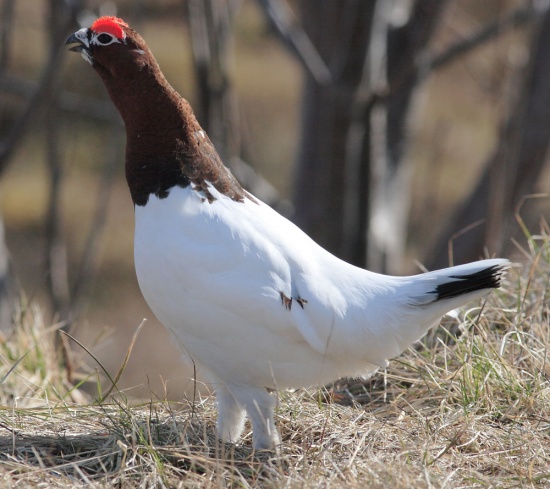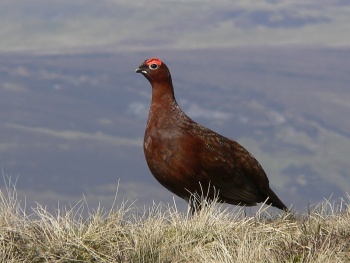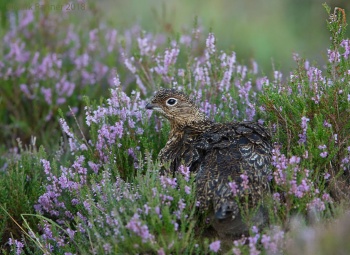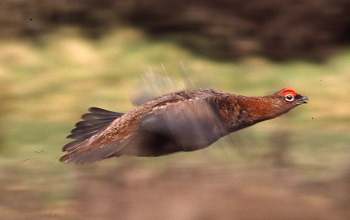Alternative name: Willow Grouse
- Lagopus lagopus
Includes: Red Grouse
Identification
36–43 cm (14¼-17 in)
Summer male - red-brown head and neck, white belly splashed with brown, black tail feathers and red wattle over eye.
Winter male - entirely white, except for black eyes, bill, and outer tail feathers, and red wattle over eye. The feet are heavily feathered and act much like snow shoes.
Summer female - mottled brown (less reddish than the male) with some white on the belly.
Winter female - identical to the winter male, except red wattle over eye smaller.
Variations
L. l. scotica does not have a white winter plumage; L. l. variegata (possibly of hybrid origin between resident L. l. lagopus and introduced L. l. scoticus) has only limited winter white.
Similar species
Rock Ptarmigan is very similar in its white winter plumage, distinguishable only by its smaller bill, and in males, black lores; in summer plumage it is much greyer, lacking rufous tones. White-tailed Ptarmigan lacks the black outer tail feathers, having a pure white tail in all plumages.
Distribution
Arctic and subarctic regions of North America, Europe and Asia, south to around 47°N in Newfoundland and eastern Siberia (Sakhalin), and to 51°N in western Canada, Britain, and the mountains of north-central Asia.
Taxonomy
Subspecies
There are 19 subspecies[1]:
- L. l. hibernica: Red Grouse
- L. l. scotica: Red Grouse
- Upland moors of Britain
- L. l. variegata
- Coastal Norway (islands off Trondheim Fjord); validity doubtful
- L. l. lagopus
- Scandinavia and northern Russia
- L. l. rossica
- L. l. birulai
- New Siberian Islands
- L. l. koreni
- Siberia to Kamchatka Peninsula
- L. l. kamtschatkensis
- Kamchatka Peninsula and Kuril Islands
- L. l. maior
- Steppes of south-western Siberia and northern Kazakstan
- L. l. brevirostris
- Altai Mountains and Sayan Mountains
- L. l. kozlowae
- Western Mongolia (Tanmu-Ola, Khangai and Kentei Mountains)
- L. l. sserebrowsky
- Eastern Siberia (Lake Baikal to Sea of Okhotsk and Sikhote Alin Mountains)
- L. l. okadai
- Sakhalin Island
- L. l. muriei
- Eastern Aleutian Islands and Kodiak Islands
- L. l. alexandrae
- Alaskan Peninsula to north-western British Columbia
- L. l. alascensis
- L. l. leucoptera
- Arctic islands of northern Canada and adjacent mainland to southern Baffin Island
- L. l. alba
- Tundra of northern Yukon and central British Columbia to Gulf of St. Lawrence
- L. l. ungavus
- L. l. alleni
The subspecies L. l. scoticus including L. l. hibernica is considered a full species, Red Grouse, by a few authors.
Habitat
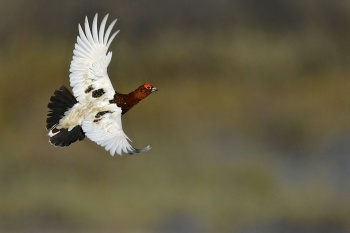
Photo © by Gerald Friesen
Nome Alaska, 4 June 2019
Tundra, thickets with alder and willow trees, open forests and shrub meadows high in the mountains where the temperature is colder.
Behaviour
Diet
The diet includes leaves and shoots of plants, especially willow Salix, heather Calluna, and birch Betula; also berries, seeds and insects.
Breeding
The nest is a hollowed out area on the ground lined with feathers and grass, sheltered by rocks or logs. The female incubates the 7-10 eggs for about 21 days while the male guards the area. The only grouse with male parental care; males have been known to attack Grizzly Bear.
References
- Clements, J. F., P. C. Rasmussen, T. S. Schulenberg, M. J. Iliff, T. A. Fredericks, J. A. Gerbracht, D. Lepage, A. Spencer, S. M. Billerman, B. L. Sullivan, M. Smith, and C. L. Wood. 2024. The eBird/Clements checklist of Birds of the World: v2024. Downloaded from https://www.birds.cornell.edu/clementschecklist/download/
- Gill, F, D Donsker, and P Rasmussen (Eds). 2024. IOC World Bird List (v 14.2). Doi 10.14344/IOC.ML.14.2. http://www.worldbirdnames.org/
Recommended Citation
- BirdForum Opus contributors. (2025) Willow Ptarmigan. In: BirdForum, the forum for wild birds and birding. Retrieved 18 May 2025 from https://www.birdforum.net/opus/Willow_Ptarmigan
External Links
Search the Gallery specifically for Red Grouse:
GSearch checked for 2020 platform.1




